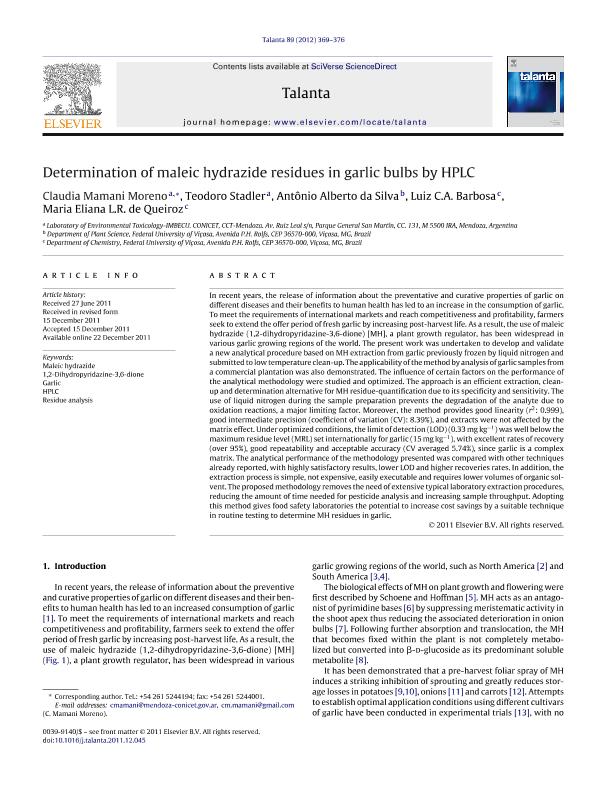Artículo
Determination of maleic hydrazide residues in garlic bulbs by HPLC
Mamani Moreno, Claudia Mariela ; Stadler, Teodoro
; Stadler, Teodoro ; da Silva, Antônio Alberto; Barbosa, Liuz C. A.; de Queiroz, María Eliana L. R.
; da Silva, Antônio Alberto; Barbosa, Liuz C. A.; de Queiroz, María Eliana L. R.
 ; Stadler, Teodoro
; Stadler, Teodoro ; da Silva, Antônio Alberto; Barbosa, Liuz C. A.; de Queiroz, María Eliana L. R.
; da Silva, Antônio Alberto; Barbosa, Liuz C. A.; de Queiroz, María Eliana L. R.
Fecha de publicación:
01/2012
Editorial:
Elsevier Science
Revista:
Talanta
ISSN:
0039-9140
Idioma:
Inglés
Tipo de recurso:
Artículo publicado
Clasificación temática:
Resumen
In recent years, the release of information about the preventative and curative properties of garlic on different diseases and their benefits to human health has led to an increase in the consumption of garlic. To meet the requirements of international markets and reach competitiveness and profitability, farmers seek to extend the offer period of fresh garlic by increasing post-harvest life. As a result, the use of maleic hydrazide (1,2-dihydropyridazine-3,6-dione) [MH], a plant growth regulator, has been widespread in various garlic growing regions of the world. The present work was undertaken to develop and validate a new analytical procedure based on MH extraction from garlic previously frozen by liquid nitrogen and submitted to low temperature clean-up. The applicability of the method by analysis of garlic samples from a commercial plantation was also demonstrated. The influence of certain factors on the performance of the analytical methodology were studied and optimized. The approach is an efficient extraction, clean-up and determination alternative for MH residue-quantification due to its specificity and sensitivity. The use of liquid nitrogen during the sample preparation prevents the degradation of the analyte due to oxidation reactions, a major limiting factor. Moreover, the method provides good linearity (r2: 0.999), good intermediate precision (coefficient of variation (CV): 8.39%), and extracts were not affected by the matrix effect. Under optimized conditions, the limit of detection (LOD) (0.33 mg kg-1) was well below the maximum residue level (MRL) set internationally for garlic (15 mg kg-1), with excellent rates of recovery (over 95%), good repeatability and acceptable accuracy (CV averaged 5.74%), since garlic is a complex matrix. The analytical performance of the methodology presented was compared with other techniques already reported, with highly satisfactory results, lower LOD and higher recoveries rates. In addition, the extraction process is simple, not expensive, easily executable and requires lower volumes of organic solvent. The proposed methodology removes the need of extensive typical laboratory extraction procedures, reducing the amount of time needed for pesticide analysis and increasing sample throughput. Adopting this method gives food safety laboratories the potential to increase cost savings by a suitable technique in routine testing to determine MH residues in garlic.
Archivos asociados
Licencia
Identificadores
Colecciones
Articulos(IMBECU)
Articulos de INST. DE MEDICINA Y BIO. EXP. DE CUYO
Articulos de INST. DE MEDICINA Y BIO. EXP. DE CUYO
Citación
Mamani Moreno, Claudia Mariela; Stadler, Teodoro; da Silva, Antônio Alberto; Barbosa, Liuz C. A.; de Queiroz, María Eliana L. R.; Determination of maleic hydrazide residues in garlic bulbs by HPLC; Elsevier Science; Talanta; 89; 1-2012; 369-376
Compartir
Altmétricas



